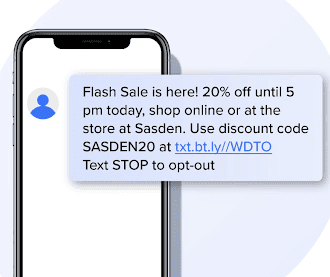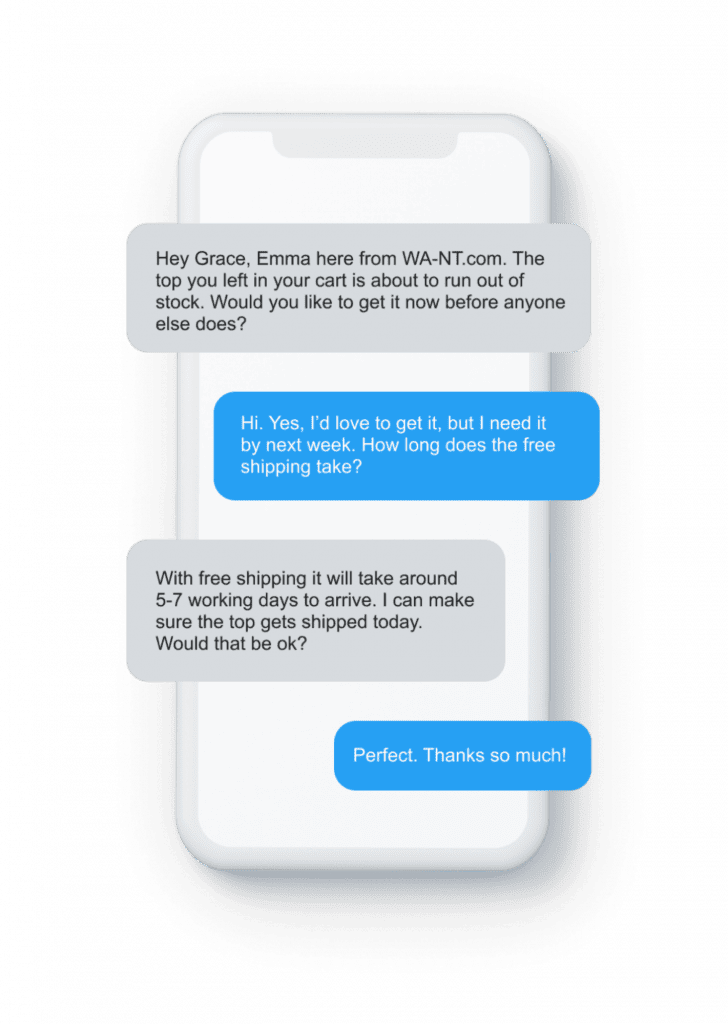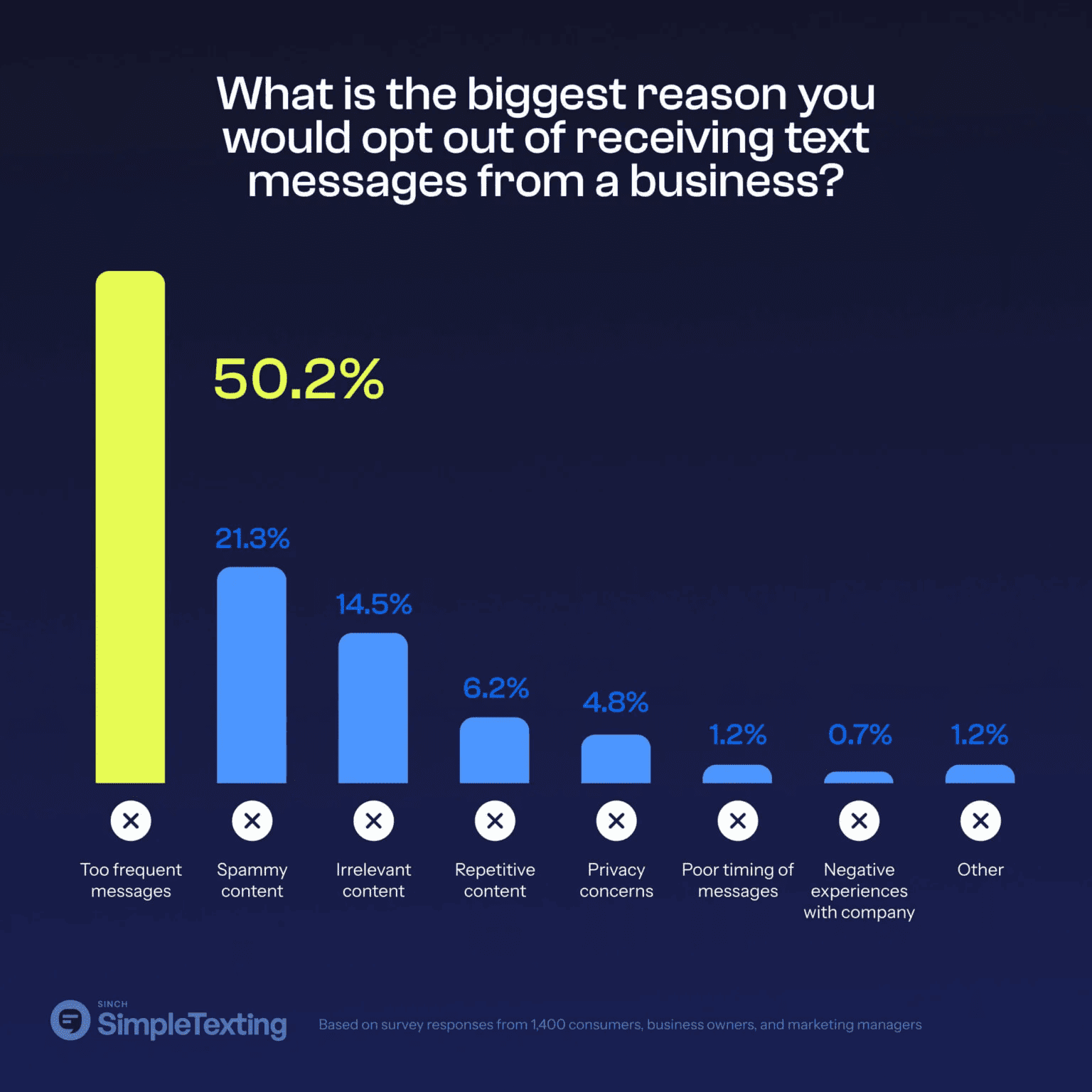Important tool updates - Learn more
- Learn
-
Articles
Read about influencer marketing
-
Growthnotes - Newsletter
Insights for the modern marketer
72% of people have bought something from a brand after getting a text message, as per Klaviyo research.
SMS marketing clearly works for e-commerce, but you’re not here for average results. You want measurable ROI and a strategy that actually converts.
To get there, you’ll need more than generic messages. In this guide, we’ll walk through the tactics and templates that actually move the needle.
Ecommerce SMS marketing involves sending timely, personalized text messages to engage customers, drive sales, and enhance loyalty.
With 98% open rates and an average ROI of $71 per $1 spent, it outperforms many other channels.
Top message types:
Tactics for boosting ROI:
Best tools to use: Klaviyo, Postscript, Omnisend, EZ Texting
Ecommerce SMS marketing involves sending promotional messages, updates, and even transactional texts directly to customers' mobile phones (ideally with their permission).
With SMS marketing, brands can use a bulk SMS service to share product launches, exclusive discounts or offers, and provide updates related to customer purchases.
Unlike social media posts, a marketing SMS goes directly to the receiver’s message inbox. It’s more directed and has a stronger chance of being opened and read by the receiver.
For e-commerce, SMS marketing can be particularly beneficial. According to a YouGov survey, 45% of people worldwide use their phones for online shopping.
Here are the main advantages of using SMS marketing for your e-commerce business:

Let’s break down the key types of eCommerce SMS messages, each with a short description and a ready-to-use template.
This message can be sent when a customer signs up for SMS updates or creates an account. A welcome message sets the tone and can even include a discount as a gesture of appreciation.
Template: 🎉 Welcome to [Brand Name]! You’re officially in. Here’s 10% off your first order: WELCOME10. Shop now → [link]

Sales promotion SMS are time-sensitive messages that alert subscribers to ongoing sales, flash deals, or seasonal promotions, which drive conversions.
Template: 🚨 FLASH SALE: 20% off everything for the next 24 hours! Use code FLASH20 at checkout. Don’t miss out → [link]

These messages are tailored to user behavior, such as past purchases or browsing history, to create a more personalized and relevant experience.
Template: Hi [First Name], based on your recent order, we think you’ll love this: [Product Name]. Get 20% off for the next 48 hours only. Tap to claim → [link]

Share exclusive, mobile-only discounts via SMS to drive urgency and increase order value.
Template: Your exclusive mobile coupon is here! Get $15 off when you spend $75+. Use code: TXT15. Shop here → [link]

P.S. Want to take your mobile strategy even further? Check out our breakdown of top mobile app marketing strategies to boost installs, engagement, and revenue.
Encourage customer interaction by asking them to text a keyword for a chance to win a prize, a giveaway, or a discount.
Template: 🏆 Win a $100 gift card! Text WIN to 12345 to enter. Contest ends Friday. Rules here → [link]

Promote a referral program that allows subscribers to earn rewards by inviting friends and family.
Template: Share & earn! Refer a friend and you’ll both get $10 off your next order. Send them this link: [referral_link]

Automatically remind customers of items left in their cart and prompt them to complete their purchase with abandoned cart reminders.
Template: Hey [First Name], you left something behind! Grab your items before they’re gone → [cart_link] + here’s 10% off: CART10

These messages promote or provide updates related to rewards and loyalty programs to your subscribers.
Template: You’ve got 150 points! Redeem them for $15 off your next order. View your rewards → [link]

Build anticipation for upcoming product launches by offering sneak peeks or early access.
Template: Sneak peek just for you: our new [Product Name] drops tomorrow! Be the first to shop → [early access link]

Request feedback on purchases via text messages. You even offer rewards for doing that.
Template: Hey, [First Name]! How do you like your recent purchase from [Brand Name]? We would love to hear from you! Leave your feedback at → [link] and earn a $5 discount code for your next purchase.

To calculate SMS marketing ROI, use the following formula:
ROI = ((Revenue from SMS Campaign – Cost of SMS Campaign) / Cost of SMS Campaign) × 100
For example, if your SMS campaign generates $1,000 in revenue and costs $200, the ROI would come out to:
ROI = (($1,000 – $200) / $200) × 100 = 400%
This means for every $1 spent, you earned $4 in return. (This is just an example, as, in reality, it could be even higher)
Although ROI is a good metric to gauge the ecommerce SMS marketing performance, you should also consider some other key metrics to get the whole picture.
For any ecommerce business spending money on SMS marketing, understanding the ROI is key. It helps in assessing the effectiveness of campaigns and making informed decisions for future strategies.
Here are a few simple reasons why you should pay close attention to the ROI of SMS marketing:
Not every ecommerce SMS marketing campaign may have a high ROI, and there can be several reasons behind that:

You can follow the tips and tactics below to get the best possible ROI from your SMS marketing campaigns for ecommerce:
First of all, you must create a high-quality subscriber list. That’s the foundation of effective SMS marketing campaigns.
So, what makes a quality SMS marketing list? Well, the recipients should match your ideal customer profile (ICP). For instance, if you’re selling nail art kits, a quality list of subscribers would primarily consist of women.
It’s highly recommended that you create a list organically over time. Here are some tips:
Make sure you collect explicit consent from customers before sending messages and adhere to compliance regulations. Use SMS marketing tools for actively managing and auditing your subscribers' list.
Audience segmentation allows for more targeted and relevant messages. When you categorize your SMS subscribers based on factors like purchase history, location, and engagement levels, you can tailor your SMS marketing campaigns to specific groups.
For instance, sending exclusive offers to loyal customers can help increase customer loyalty and lifetime value. You’ll need data, of course, to segment your audience, which you can get from your current tech stack, like the SMS marketing platform you’re using or a customer relationship management (CRM) system.
Here are some segmentation examples:
Personalized messaging can dramatically improve customer engagement. 76% of consumers are more likely to buy from a brand that delivers personalized experiences, according to McKinsey.

In the context of SMS, you can incorporate customer names, past purchase details, and personalized product recommendations in your texts. This approach improves the customer experience and may also result in higher conversion rates.
Most paid SMS marketing platforms offer features that facilitate personalized SMS marketing efforts, so achieving personalization in SMS marketing is very much doable.
Timing plays a crucial role in the effectiveness of SMS marketing messages. You don’t want to bother people at the wrong hour or too frequently. Similarly, you should send out the texts at a time when the receivers are more likely to read and act on them.
For example, for ecommerce brands, sending messages during work hours wouldn’t be ideal. Afternoons on weekends tend to perform better, as users are more relaxed and actively on their phones.
Recent trends suggest that Thursdays, Fridays, and Saturdays deliver the best results, especially during 9 AM to 12 PM and 5 PM to 9 PM. These time slots align with when most users check their phones, either before work, during breaks, or in the evening wind-down window.
You should also time messages based on the desired action. For example, sending a cart reminder within an hour of abandonment significantly increases the chance of recovering the sale.
AI-driven platforms analyze customer behavior to schedule messages when they are most likely to be read.
Every SMS message should have a concise and compelling CTA. Whether it's prompting customers to visit your website, use a discount code, or check out a new product, a clear CTA guides the customer towards the desired action.
Also, make sure that the CTA is prominently placed within the 160-character limit to maximize its impact. Include links so your audience can directly hop on to the website to make the purchase.
Some clear and effective CTA examples for ecommerce SMS marketing are:
Pro Tip: Use Generative AI to create catchy but relevant CTAs for your text messages. Many marketers are already doing this.
A/B testing lets you compare different versions of your SMS messages to determine which performs better. You can test variables such as message content, send time, and CTA to identify what resonates most with your audience.
For instance, tools like Postscript provide A/B testing features, which let you refine your messaging strategy based on real-time data. You can essentially have two different versions of the same type of marketing SMS to see which one performs better.
“A/B testing is really beneficial for companies of any size. Testing allows brands to learn what tactics perform best with their audience. They can then take those learnings and apply them to future decisions, taking the guesswork out of finding what resonates with their users,” Abigail Beene, HawkSEM.
Incentivizing customers through exclusive discounts, promo codes, or interactive games can be a great tactic to increase engagement. For instance, you may send a unique discount code via SMS to push for immediate purchases.
Similarly, interactive campaigns, like SMS-based games, are entertaining and may also help create deeper connections with your audience, especially if that audience is young, like Gen Z.
If you happen to have location data about the subscribers in your list, you can use it to add more relevance and personalization to your text messages. You can even send out location-based offers for leads in a specific city or town.
This tactic is more suitable for an e-commerce brand with a physical presence. SMS marketing can drive foot traffic in addition to online orders. Even if you don’t have a physical store, you can still send location-specific offers, such as free delivery in a specific state or city.
Again, make sure that you have the necessary permissions to use location data and that your messages provide value to the recipient.
Combine SMS with other marketing channels, such as email campaigns and social media, to create a cohesive customer journey.
For example, follow up an email campaign with a timely SMS reminder. Similarly, send out links to social media posts with offers via text to increase visibility.
All your marketing channels can be streamlined to promote offers and consistently keep potential customers engaged. It’s great to stay top-of-mind, especially if you’re selling high-ticket items that have long sales funnels.
With the right integrations, you can easily integrate your SMS marketing platform with other marketing channels.
Multi-channel marketing can be quite lucrative. 50% of marketers say they hit their financial targets with multi-channel marketing.
Last but not least, regularly monitor key performance indicators (KPIs) for your e-commerce SMS marketing campaigns. Typically, the key metrics you should watch out for are:
Use dedicated analytics tools or any analytics feature in your SMS marketing tool to gain valuable insights. Analyzing this data helps refine your messaging strategy, optimize campaign performance, and ultimately improve ROI over time.
In addition to specific SMS campaigns, set up automated workflows for specific texts. You can use an advanced SMS marketing tool to set up automatic text messages when a certain action is taken.
For example, you can set up an automatic ‘Welcome’ text message for new subscribers added to the list. Similarly, the abandoned cart reminder messages can also be automated by integrating your store with the SMS marketing platform. That way, you don’t have to do it manually. The text goes to the customer automatically.
Automations like these can also help improve ROI indirectly. And your marketers are freed up to do more important things.
SMS marketing should be a key component of e-commerce brands' overall marketing strategy. It can potentially have a higher ROI than pay-per-click (PPC) and social media campaigns.
Use the tactics and templates above to realize an impactful ecommerce SMS marketing strategy.
SMS marketing can also be great for go-to-market in new cities and countries. If you need help with marketing on an international level, explore the best global marketing agencies.
Yes, SMS marketing is legal when businesses adhere to regulations such as the Telephone Consumer Protection Act (TCPA) in the U.S. and the General Data Protection Regulation (GDPR) in the EU. This includes obtaining explicit consent from customers before sending promotional messages and providing clear opt-out instructions in every message.
Non-compliance can result in fines ranging from $500 to $1,500 per violation.
SMS compliance means following legal guidelines, like getting clear consent before messaging, offering easy opt-outs, and keeping records of user permissions. These rules protect consumer privacy and help you avoid fines or legal trouble. A reliable SMS platform should support full compliance management by default.
The best SMS marketing tools for eCommerce offer features like automation, segmentation, and performance tracking. Top picks include Klaviyo for its deep eCommerce integrations, Postscript for Shopify-specific automation, Omnisend for combining email and SMS, and EZ Texting for easy-to-use mass messaging tools.
Yes, SMS marketing can be highly profitable. On average, businesses see a return of $71 for every dollar spent on SMS marketing. That’s a 700% ROI or 71x return. Also, text messages have high engagement rates, with an open rate of 98%. However, only campaigns executed with a strong strategy and the right tactics can achieve this level of profitability.
Some effective SMS marketing campaigns are:
Conversion rates for SMS marketing in e-commerce can vary, but research shows an average range of 21% to 32%. Message content, timing, and audience segmentation can heavily influence SMS conversion rate. Use analytics tools to track and optimize these factors. That can lead to improved campaign performance.